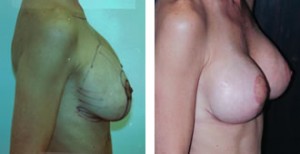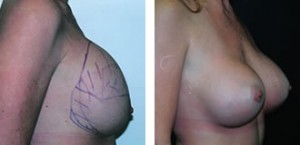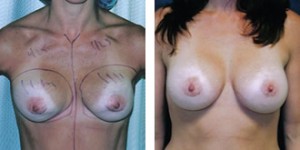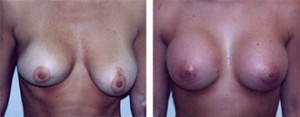Breast Revision in Hollywood – Double-Bubble Breast Deformity and Ruptured Implants
Posted On: November 10, 2008 Author: The Office of Dr. Stuart Linder Posted In: Breast Revision, Home
Double-Bubble Breast Deformity and Ruptured Implants
We see patients with double-bubble deformities associated with poorly positioned implants. In my Beverly Hills practice, I very much enjoy fixing and repairing breasts that present with a double-bubble deformity. This means simply that the breast implant is too high and the skin over-drapes it. The nipple is often low on the breast and along the lower pole and the implant is superiorly retropositioned. This normally is associated with poorly placed implants directly from the original surgery either transumbilical or transaxillary. If the parasternal and inframammary portions of the pectorals major muscle are not adequately released, the implant will never fall to a normal position and the implant will be raised superiorly, as if being pinched up with a catcher’s net.
The double-bubble deformity is correctable by several staged operations. The first component of the surgery includes releasing the scar tissue as an open capsulotomy with inferiorly or lowering the implant and the pocket.
The second component may require a breast lift, usually a formal mastopexy where skin is removed around the nipple vertically along the inframammary fold. This will tighten the skin envelope after the implant is now correctly positioned inferiorly. Ruptured implants occur all the time. In general, implants are not lifetime devices. In fact, they can rupture at any time after implantation. Breast implants when ruptured should be removed as soon as possible in order to prevent further collapse of scar tissue around the bags which could cause more difficulty in creating a normal appearance.
Silicone implant ruptures are usually only detectable with MRIs, as they remain silent even with mammograms which are often not sensitive to rupture.
In my practice, patients are asked to have an MRI performed every two to three years after implantation of silicone implants under the muscle.
Patients who have ruptured implants often present to us from throughout the Western hemisphere.
Sometime they no longer have surgeons who have taken care of them in the past because the patients have moved, the surgeon may have passed away or the patient no longer feels comfortable with that specific physician.
As a result, Dr. Linder very much enjoys repairing implants with double-bubble deformities and/or explantation and reimplantation with capsulectomies and/or capsulotomies after ruptured or deflated saline or silicone implants.



